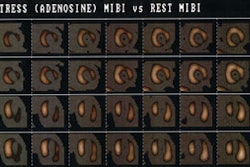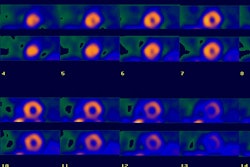J Nucl Med 1995 Nov;36(11):2044-9
Indium-111-antimyosin and iodine-123-MIBG studies in early assessment of
doxorubicin cardiotoxicity.
Carrio I, Estorch M, Berna L, Lopez-Pousa J, Tabernero J, Torres G.
Detection of myocyte cell damage with 111In-antimyosin and impairment of
adrenergic neuron function with [123I]MIBG during doxorubicin administration may
provide easy identification of patients at risk of significant functional
impairment. METHODS: We studied 36 cancer patients who underwent chemotherapy,
including doxorubicin, to assess [123I]MIBG and 111In-antimyosin uptake in the
course of doxorubicin administration. MIBG scans, antimyosin scans and ejection
fraction measurements were performed before chemotherapy, at intermediate
cumulative doses and at maximal cumulative doses of doxorubicin. MIBG uptake was
quantified by a heart-to-mediastinum ratio and antimyosin uptake was quantified
by a heart-to-lung ratio. RESULTS: All patients had absent antimyosin uptake
(mean ratio 1.40 +/- 0.06) with normal MIBG uptake (ratio 1.85 +/- 0.29) before
chemotherapy; ejection fraction was 61% +/- 8%. With a 240-300 mg/m2 dose of
doxorubicin, an increase in antimyosin uptake was observed with a ratio of 1.85
+/- 0.2 (p < 0.01), whereas a similar degree of MIBG uptake was observed
(mean ratio of 1.80 +/- 0.2, p = ns); ejection fraction was 59% +/- 5% (p = ns).
At 420-600 mg/m2, increased antimyosin uptake was observed with a ratio of 2.02
+/- 0.3 (p < 0.01), and a decrease in MIBG uptake was also observed (mean
ratio of 1.76 +/- 0.2, p < 0.05); ejection fraction was 52% +/- 8% (p <
0.05). Patients with more intense antimyosin uptake at intermediate doses tended
to be those with more severe functional impairment at maximal cumulative doses.
CONCLUSION: At cumulative doses of 420-600 mg/m2, antimyosin and MIBG studies
detect cell damage and impaired adrenergic neuron activity in patients with
maintained or slightly decreased ejection fraction.



